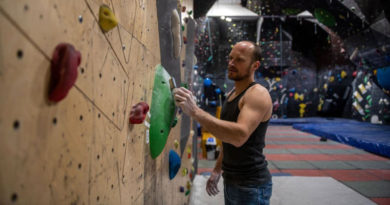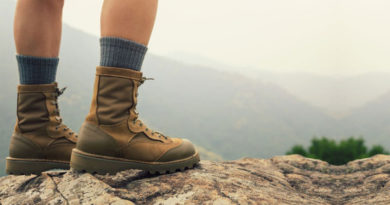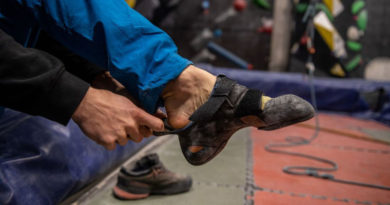How to Break In Mountaineering Boots?
Mountaineering boots can be quite stiff and uncomfortable when new. The stiffness is meant to provide support, stability, and protection in challenging environments. However, with a proper break-in, they can become more comfortable and fit better. In this blog post, I will explain how you can break in your mountaineering boots to ensure a comfortable fit. I will also explain custom fit and methods to minimize the risk of blisters and other foot problems.
Wear your boots around the house
Before going on a hike, wear your boots around the house. This will make your feet become familiar with the boots. It will allow the boots to conform to the shape of your feet. Wearing your boots around the house for short periods of time is an excellent way to break them in and minimize discomfort gradually.
When breaking in your boots, wear the same socks you’ll be wearing on your hike. This is because the socks you wear can affect the fit of your boots. If you wear thinner socks during the break-in period and then wear thicker socks during the hike, it will impact the overall fit. The same pair of socks also help your boots conform to the shape of your feet.
Wearing your boots around the house also allows you to adjust the laces and make any necessary adjustments to the fit. Before embarking on a hike, make certain that your boots are properly laced. This will help to prevent foot injuries and blisters while also ensuring a comfortable hiking experience.
Short hikes to break in your boots
After you’ve worn your boots around the house a few times, you can start taking them on short hikes. Begin with short, easy hikes and gradually increase the length and difficulty as your feet become more comfortable in the boots. This will help the boots break in slowly and will minimize the risk of blisters and other foot problems.
Pay attention to any pressure points or hot spots on your feet. Adjust the lacing or make any necessary changes to the fit of your boots if you experience any discomfort. To avoid blisters and other foot problems, it’s critical to address any discomfort as soon as possible.
Gradually increase the length and difficulty of your hikes as you progress through your short hikes. This will allow your feet and boots to adjust and break in further. But it’s important not to go overboard. Pay attention to your body’s signals and refrain from exerting too much or too quickly.
Remember, breaking in any pair of boots takes time and it’s important to be patient and persistent. Avoid cutting corners or rushing the procedure to avoid foot problems or blisters on your hike.
Pay attention to discomfort
If you feel pressure points or hot spots on your feet, stop hiking immediately and adjust the fit of the boots. You may need to adjust the lacing or loosen or tighten the boots in certain areas to alleviate discomfort. Paying attention to any areas of your feet where the boots feel tight or uncomfortable will help you identify pressure points and hot spots. The pain can occur on the sides, top, or bottom of your feet. You can also feel pain at the heels or toes. Note that some discomfort is normal during the break-in period. However, if you are feeling persistent discomfort or pain, it is a sign that your boots aren’t providing a proper fit.
You can adjust the fit of your boots to relieve discomfort once you’ve identified any pressure points or hot spots. This could include adjusting the insoles, loosening or tightening the laces, or using padding or moleskin to protect sensitive areas of your feet. It’s important to address any discomfort or pressure points early in the breaking-in process. If left untreated, pain can quickly turn into blisters or other foot problems. Remember, prevention is key, and taking the time to break in your boots properly will pay off in the long run.
Take care of your feet
Another important aspect of breaking in boots is to take care of your feet. This means keeping your feet clean and dry and wearing moisture-wicking socks to prevent blisters. To prevent friction, you can also use a lubricant or anti-chafing cream. You can apply these lubricants or creams to the areas of your feet that are prone to blisters. Wash your feet daily and thoroughly dry them, especially between the toes. Keep them dry because moisture can quickly lead to blisters. Moisture-wicking socks can help prevent blisters by keeping your feet dry and reducing friction. They’re designed to pull moisture away from your feet and prevent it from accumulating in your socks or boots.
Finally, it’s important to promptly take care of any blisters or other foot problems. This involves cleaning the affected area, applying a blister pad or moleskin, and taking a break from hiking if necessary to allow your feet to heal.
Importance of patience and persistence
Breaking in boots is not a quick or easy process. You need to approach it with patience and persistence. Acknowledging that breaking in your boots takes time can help manage your expectations and prevent frustration or disappointment. Remember that a comfortable and custom fit is worth your effort and time.
During the breaking-in process, it’s important to stay committed and persistent. This involves wearing your boots regularly, even when you’re not hiking. You should also gradually increase the length and intensity of your hikes. Even though you might feel like quitting or switching to more comfortable boots, it’s better to stay with your mountaineering boots in the end.
Remember that everyone’s feet are unique, so what works for one person may not work for someone else. It might require some experimenting and trying different methods to find the right adjustments and techniques.
Conclusion
In conclusion, breaking in mountaineering boots is an essential step in preparing for a successful and comfortable hiking experience. You can break in your boots by wearing them around the house followed by going on short hikes. Also, pay attention to any discomfort as a result of hot spots. Remember that breaking in is a process that takes time, so stay patient and persistent. However, by remaining committed to the process and approaching it positively, you can ensure a comfortable and enjoyable hiking experience for years to come. So, lace up those boots, hit the trail, and enjoy the beauty of the great outdoors with the confidence that your feet are properly protected and supported.




